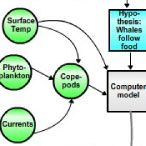|
|
Click Images to Enlarge
|
||||||||||
About this Workshop:
For this workshop, 15 graduate students from UMaine and 2 post-doctoral researchers were matched with New England-region ocean and climate scientists to improve their collective understanding of Earth's major ocean - climate systems. [more]
About this Scientist:
Andrew Pershing is an ecosystems modeler. The primary focus of his research is to understand what causes the Gulf of Maine ecosystem to change from one year to the next. His work details how alterations in conditions in the Labrador Sea impact plankton communities in the Gulf of Maine which subsequently lead to changes in populations of fish and whales.
As the Gulf of Maine Research Institute's ecosystem modeler, Andy develops computer models that reconstruct and forecast changes in zooplankton in the Gulf of Maine. He currently leads a project that uses satellite data and computer models to predict the location of endangered North Atlantic right whales in the Gulf of Maine. [more]












